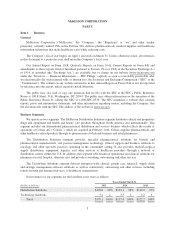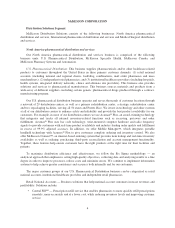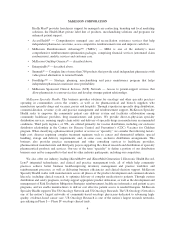McKesson 2015 Annual Report Download - page 18
Download and view the complete annual report
Please find page 18 of the 2015 McKesson annual report below. You can navigate through the pages in the report by either clicking on the pages listed below, or by using the keyword search tool below to find specific information within the annual report.McKESSON CORPORATION
The majority of our U.S. pharmaceutical distribution business agreements with manufacturers are structured
to ensure that we are appropriately and predictably compensated for the services we provide; however, failure to
successfully renew these contracts in a timely and favorable manner could have a material adverse impact on our
results of operations. In addition, branded pharmaceutical price inflation can be the partial economic basis of
some of our distribution business agreements with pharmaceutical manufacturers. If the frequency or rate of
branded price increases slows, it could have a material adverse impact on our results of operations.
In addition, we distribute generic pharmaceuticals, which can be subject to both price deflation and price
inflation. In recent years, our financial results have improved from our generic drug offerings combined with an
increase in the number of generic drugs available in the marketplace. In fiscal year 2016, we anticipate the
number of branded to generics conversions to increase as compared to the prior year. Continued volatility in the
availability, pricing trends or reimbursement of these generic drugs, or significant fluctuations in the rate of
increase in the number of generic drugs, could have a material adverse impact on our results of operations.
Generic drug manufacturers are increasingly challenging the validity or enforceability of patents on branded
pharmaceutical products. During the pendency of these legal challenges, a generics manufacturer may begin
manufacturing and selling a generic version of the branded product prior to the final resolution of its legal
challenge over the branded product’s patent. To the extent we source, contract manufacture, and distribute such
generic products, the brand-name company could assert infringement claims against us. While we generally
obtain indemnification against such claims from generic manufacturers as a condition of distributing their
products, there can be no assurances that these rights will be adequate or sufficient to protect us.
The healthcare industry is highly regulated and further regulation of our distribution businesses and
technology-related products and services could impose increased costs, negatively impact our profit margins, and
the profit margins of our customers, delay the introduction or implementation of our new products, or otherwise
negatively impact our business and expose the Company to litigation and regulatory investigations.
Healthcare Fraud: We are subject to extensive and frequently changing local, state and federal laws and
regulations relating to healthcare fraud, waste and abuse. Local, state and federal governments continue to
strengthen their position and scrutiny over practices involving fraud, waste and abuse affecting Medicare,
Medicaid and other government healthcare programs. Our relationships with pharmaceutical and medical-
surgical product manufacturers and healthcare providers, as well as our provision of products and services to
government entities, subject our business to laws and regulations on fraud and abuse, which among other things:
(1) prohibit persons from soliciting, offering, receiving or paying any remuneration in order to induce the referral
of a patient for treatment or to induce the ordering or purchasing of items or services that are in any way paid for
by Medicare, Medicaid or other government-sponsored healthcare programs; (2) impose a number of restrictions
upon referring physicians and providers of designated health services under Medicare and Medicaid programs;
and (3) prohibit the knowing submission of a false or fraudulent claim for payment to, and knowing retention of
an overpayment by, a federal healthcare program such as Medicare and Medicaid. Many of the regulations
applicable to us, including those relating to marketing incentives, are vague or indefinite and have not been
interpreted by the courts. The regulations may be interpreted or applied by a prosecutorial, regulatory, or judicial
authority in a manner that could require us to make changes in our operations. If we fail to comply with
applicable laws and regulations, we could become liable for damages and suffer civil and criminal penalties,
including the loss of licenses or our ability to participate in Medicare, Medicaid and other federal and state
healthcare programs.
Reimbursements: Both our profit margins and the profit margins of our customers may be adversely affected
by laws and regulations reducing reimbursement rates for pharmaceuticals, medical treatments and related
services, or changing the methodology by which reimbursement levels are determined. For example, the Patient
Protection and Affordable Care Act and the Health Care and Education Reconciliation Act (collectively the
“Affordable Care Act”), signed into law in 2010, revised the federal upper limits for Medicaid reimbursement for
13
























